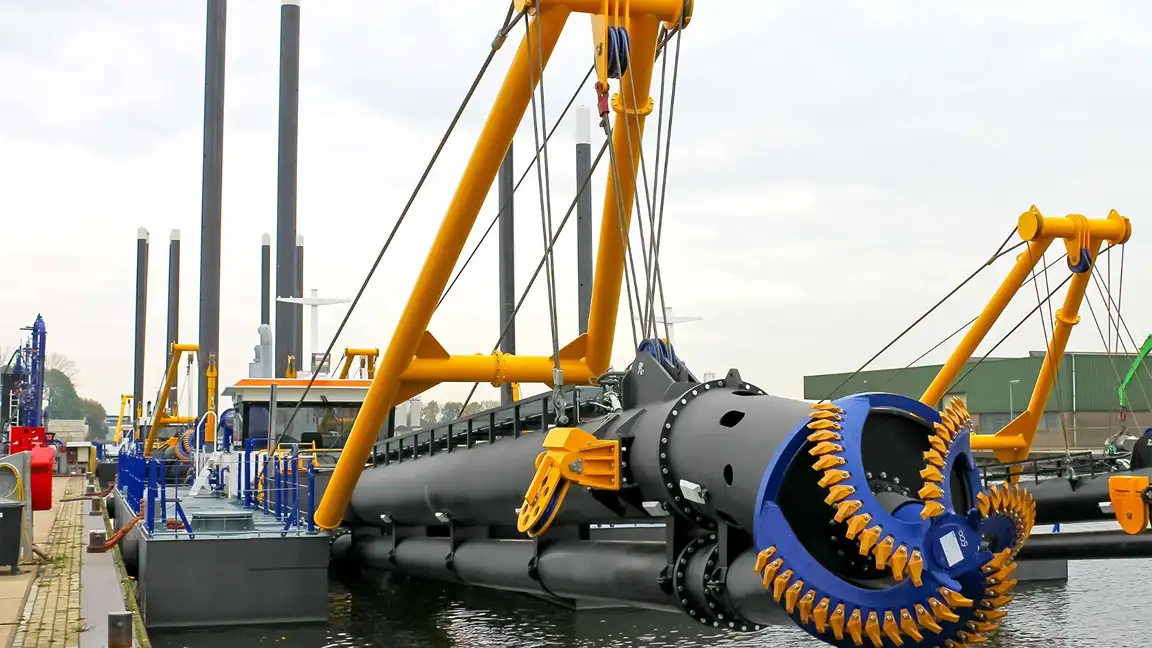Introduction
In the evolving world of marine engineering, innovation is not just about power—it’s about adaptability. As terrain conditions grow more challenging and project demands increase, modern dredging requires machinery that’s both efficient and flexible. This is where Dragflow’s DRM dredger steps into the spotlight. A revolutionary machine, the DRM dredger breaks from convention with its pontoon-free design, enabling unmatched mobility, stability, and operational efficiency. In this article, we explore how this breakthrough is changing the landscape of dredging operations across the globe.
What is the DRM Dredger?
The DRM dredger is an amphibious dredging unit engineered by Dragflow, a leading manufacturer in advanced dredging solutions. Unlike conventional models, the DRM operates without pontoons, thanks to its integrated tracked undercarriage. This design enables the machine to move seamlessly between land and water, eliminating the need for external transport or assembly systems.
Equipped with a powerful 10-inch submersible dredge pump, the DRM dredger is built to handle sediment-rich environments with high efficiency. Its ability to operate in shallow, confined, or soft-bottom areas makes it an ideal solution for applications ranging from industrial ponds and lagoons to marshland and dam basins.
The Traditional Dredger vs. Pontoon-Free Innovation
Conventional dredgers rely heavily on pontoons for flotation and stability. While effective in deep or open water, pontoons pose limitations in shallow, soft, or inaccessible terrains. They often require support equipment for mobilization, face restrictions in confined areas, and present logistical challenges during deployment.
The pontoon-free dredger like the DRM eliminates these constraints. By incorporating tracked mobility directly into the body of the machine, Dragflow has created a unit capable of walking across land, entering water under its own power, and conducting dredging without external platforms or flotation aids. This shift in design represents a significant step forward in terms of operational freedom and cost efficiency.
Advantages of the Pontoon-Free Design
1. Unmatched Maneuverability
The DRM dredger’s tracked undercarriage allows it to maneuver in environments where traditional dredgers cannot function. Whether traversing marshland, sandbanks, or steep shorelines, the DRM moves independently and efficiently.
2. Enhanced Stability
On soft or uneven terrain, pontoons can tip or shift, compromising safety and performance. The DRM dredger’s stable, low-profile design ensures a steady base, which is especially important during high-precision excavation.
3. Rapid Deployment
With no need for crane support or pontoon assembly, the DRM dredger drastically reduces setup time. This leads to quicker project starts, shorter timelines, and less dependency on auxiliary equipment—resulting in cost savings and increased productivity.
Terrain Versatility and Real-World Applications
The DRM dredger was engineered with multi-terrain adaptability in mind. It performs exceptionally well in a range of environments:
- Marshes and Wetlands – Perfect for restoration or conservation work where traditional dredgers would sink or stall.
- Dam Basins – Able to navigate sediment-filled reservoirs and remove material with minimal disruption.
- Industrial Ponds – Capable of entering compact, shallow spaces often inaccessible to larger pontoons.
- Flood-Control Channels – Ideal for urban or semi-urban waterways with tight access and changing elevations.
Its versatility makes the pontoon-free dredger a go-to choice for public works, environmental agencies, and private contractors alike.
Environmental and Economic Impact
By reducing the amount of heavy support machinery needed for transport and deployment, the DRM dredger offers a smaller operational footprint. Its precise, controlled excavation minimizes disturbance to aquatic ecosystems and sediment resuspension.
Economically, the reduced setup time and labor requirements translate into significant project savings. Whether used for short-term emergency dredging or long-term environmental remediation, the DRM dredger delivers results without excessive overhead.
The Future of Dredging: Innovation Through Design
Dragflow’s DRM dredger is more than just a machine—it represents a shift in thinking. The move toward pontoon-free dredgers marks a new chapter in engineering design, where responsiveness to real-world conditions takes precedence over one-size-fits-all machinery.
As environmental considerations and terrain diversity become greater challenges, innovations like the DRM are setting new benchmarks for what dredging equipment can and should do.
Conclusion
The DRM dredger is not simply a new tool—it’s a smarter one. Its pontoon-free design offers unmatched mobility, stability, and versatility, making it an essential solution for modern dredging challenges. From marshes to industrial sites, and from environmental projects to emergency response, this innovative dredger brings both flexibility and performance to the forefront.
As dredging demands continue to evolve, it’s clear that machines like the DRM will play a pivotal role in shaping the future—on land, in water, and everywhere in between.
